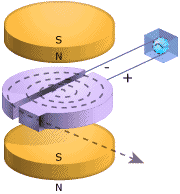|
 |
| In the cyclotron
the particles are accelerated twice per turn by
an alternating voltage. |
|
|
|
Problems with electric
breakdowns limit accelerating voltages to about a
megavolt. Ernest Lawrence invented the principle of
repeated acceleration where particles pass the same
accelerating voltage many times. Then a more modest
voltage could be used and still very powerful
acceleration could be achieved. A powerful magnetic
field made the charged particle follow an almost
circular orbit and forced them to go through the
accelerating field several times. With this circular
accelerator, considerably higher energies could be
achieved and the new invention led to a rapid
development of the accelerator technique.
Ernest Lawrence received the
Nobel Prize in 1939 "for the invention and
development of the cyclotron and for results obtained
with it, especially with regard to artificial
radioactive elements."
|